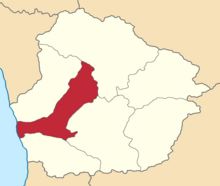Senaki uezd
Senaki uezd
Сенакскій уѣздъ | |
|---|---|
 Location in the Kutais Governorate | |
| Country | Russian Empire |
| Viceroyalty | Caucasus |
| Governorate | Kutaisi |
| Established | 1867 |
| Abolished | 1930 |
| Capital | Senaki |
| Area | |
| • Total | 2,127.27 km2 (821.34 sq mi) |
| Population (1916) | |
| • Total | 159,678 |
| • Density | 75/km2 (190/sq mi) |
| • Urban | 11.73% |
| • Rural | 88.27% |
The Senaki uezd[a] was a county (uezd) of the Kutaisi Governorate of the Caucasus Viceroyalty of the Russian Empire. It bordered the Zugdidi uezd to the west, the Lechkhumi uezd to the north, the Kutaisi uezd to the east, and the Ozurgeti uezd to the south. The area of the uezd corresponded to most of the contemporary Samegrelo-Zemo Svaneti region of Georgia. The Senaki uezd was eponymously named for its administrative center, Senaki.[1]
History
The Senaki uezd was formed in 1846 as part of the Kutaisi Governorate on the territory of the historical region of Samegrelo during the time of the Russian Empire. In 1918, the Kutaisi Governorate including the Senaki uezd was incorporated into part of the Democratic Republic of Georgia.[1]
Administrative divisions
The subcounties (uchastoks) of the Senaki uezd were:[2]
| Uchastok | Russian name | 1912 population |
|---|---|---|
| Abasha | Абашскій участокъ | 20,740 |
| Bandzinskiy | Бандзинскій участокъ | 15,246 |
| Martvili | Мартвильскій участокъ | 20,218 |
| Senaki | Сенакскій участокъ | 7,587 |
Demographics
Russian Empire census (1897)
According to the Russian Empire census of 1897, the Senaki uezd had a population of 115,785, including 58,585 men and 57,200 women. The majority of the population indicated Mingrelian to be their mother tongue, with a significant Georgian speaking minority.[3]
| Language | Native speakers | % |
|---|---|---|
| Mingrelian | 96,851 | 83.65 |
| Georgian | 14,338 | 12.38 |
| Russian | 1,395 | 1.20 |
| Imeretian | 895 | 0.77 |
| Armenian | 448 | 0.39 |
| Jewish | 448 | 0.39 |
| Greek | 401 | 0.35 |
| Polish | 175 | 0.15 |
| Turkish | 173 | 0.15 |
| Ukrainian | 124 | 0.11 |
| English | 85 | 0.07 |
| Lithuanian | 72 | 0.06 |
| German | 71 | 0.06 |
| Tatar[b] | 64 | 0.06 |
| Svan | 63 | 0.05 |
| Abkhaz | 24 | 0.02 |
| Romanian | 17 | 0.01 |
| Kurdish | 3 | 0.00 |
| Ossetian | 3 | 0.00 |
| Persian | 2 | 0.00 |
| Avar-Andean | 1 | 0.00 |
| Belarusian | 1 | 0.00 |
| Estonian | 1 | 0.00 |
| Other | 130 | 0.11 |
| TOTAL | 115,785 | 100.00 |
Caucasian Calendar (1917)
According to the 1917 publication of the Caucasian Calendar, the Senaki uezd had 159,678 residents in 1916, including 86,448 men and 73,230 women, 149,112 of whom were the permanent population, and 10,566 were temporary residents:[4]
| Nationality | Urban | Rural | TOTAL | |||
|---|---|---|---|---|---|---|
| Number | % | Number | % | Number | % | |
| Georgians | 12,441 | 66.42 | 139,303 | 98.83 | 151,744 | 95.03 |
| Russians[c] | 2,836 | 15.14 | 4 | 0.00 | 2,840 | 1.78 |
| Jews | 847 | 4.52 | 1,639 | 1.16 | 2,486 | 1.56 |
| Armenians | 1,529 | 8.16 | 0 | 0.00 | 1,529 | 0.96 |
| Asiatic Christians | 769 | 4.11 | 0 | 0.00 | 769 | 0.48 |
| Other Europeans | 239 | 1.28 | 0 | 0.00 | 239 | 0.15 |
| Sunni Muslims[d] | 70 | 0.37 | 0 | 0.00 | 70 | 0.04 |
| North Caucasians | 0 | 0.00 | 1 | 0.00 | 1 | 0.00 |
| TOTAL | 18,731 | 100.00 | 140,947 | 100.00 | 159,678 | 100.00 |
Notes
- ^
- ^ Later known as Azerbaijani.
- ^ The Caucasian Calendar did not distinguish between Russians, Ukrainians, and Belarusians.
- ^ Primarily Turco-Tatars.[5]
References
- ^ a b Tsutsiev, Arthur (2014). Atlas of the Ethno-Political History of the Caucasus. Translated by Nora Seligman Favorov. New Haven: Yale University Press. ISBN 9780300153088.
- ^ Кавказский календарь на 1913 год [Caucasian calendar for 1913] (in Russian) (68th ed.). Tiflis: Tipografiya kantselyarii Ye.I.V. na Kavkaze, kazenny dom. 1913. pp. 160–167. Archived from the original on 19 April 2022.
- ^ "Демоскоп Weekly - Приложение. Справочник статистических показателей". www.demoscope.ru. Retrieved 2022-06-27.
- ^ Кавказский календарь на 1917 год [Caucasian calendar for 1917] (in Russian) (72nd ed.). Tiflis: Tipografiya kantselyarii Ye.I.V. na Kavkaze, kazenny dom. 1917. pp. 198–205. Archived from the original on 4 November 2021.
- ^ Hovannisian 1971, p. 67.
Bibliography
- Hovannisian, Richard G. (1971). The Republic of Armenia. Vol. 1. Berkeley: University of California Press. ISBN 0-520-01805-2.
- Pages with non-numeric formatnum arguments
- Articles containing Russian-language text
- Articles containing Georgian-language text
- CS1 Russian-language sources (ru)
- Articles with short description
- Short description with empty Wikidata description
- Pages using infobox settlement with no coordinates
- All stub articles
- Georgia (country) history stubs
- Caucasus stubs
- Russia stubs
- Coordinates not on Wikidata
- Uezds of Kutaisi Governorate
